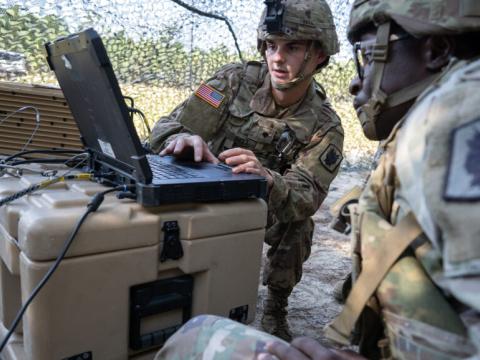Researchers Jam More Data Through the Pipes
Flexible signaling capability pushes information to warfighters at the tip of the spear.
An experimental communications system may provide future combat vehicle crews with access to high-bandwidth intelligence and command and control applications. Part of a larger U.S. Defense Department effort to improve troops’ ability to receive and send data, this research program is developing technologies to open communications channels down to the most spectrum-starved tactical user.
Network-centric warfare relies on units across all echelons accessing and sharing sensor and communications data. Operation Iraqi Freedom demonstrated this need when advancing coalition units became separated from their command elements and had difficulty achieving situational awareness. Future combat missions will require the very tip of the spear—small teams of armored vehicles or motorized infantry—to be able to view the broad battlespace.
The Defense Advanced Research Projects Agency (DARPA), Arlington, Virginia, has designed several programs to increase the amount of data flowing to warfighters under the umbrella of its Future Combat Systems (FCS) program. One effort under FCS is the Mobile Networked Multiple-Input, Multiple-Output (MNM) program, which seeks to develop technologies for spectrally efficient, mobile ad hoc network communications.
According to MNM program manager Dr. James Freebersyser, the system relies on multiple input, multiple output (MIMO) technology to increase spectrum use efficiency and to maintain an antijamming, low-probability-of-detection capability for mobile networks. Because MNM requires multiple antennas, it is intended primarily for ground vehicles rather than unattended ground sensors, dismounted infantry or unmanned aerial vehicles.
As an offshoot of FCS, MNM is designed to operate with the joint tactical radio system (JTRS) and its wideband networking waveform. Freebersyser notes that his program is developing its own MIMO-based wideband networking waveform that will carry the same types of data found on the tactical Internet such as voice, video, and command and control applications. MIMO also uses approaches developed for other DARPA efforts such as the Next Generation Communications (XG) program (SIGNAL, December 2003, page 45).
While XG seeks ways to use unallocated spectrum without causing interference for the intended user, MIMO’s goal is to find more efficient ways to transmit those communications, according to Freebersyser. Instead of providing a tactical-level bandwidth management scheme, MNM intends to create the largest possible data pipe for tactical users. “We’re just trying to see how much we can jam through a particular amount of spectrum. In the sense that we’re allowing more information to be sent in the same amount of spectrum—I guess that’s bandwidth management to some degree. But it’s kind of a brute force technique,” he explains.
Mobility is a major challenge for MNM because the technique requires a large amount of channel training—a synchronization scheme where transmitters and receivers share common information references sent in each data packet to acquire multipath signals more efficiently. Freebersyser notes that the difficulty lies in ensuring the system is actually moving data instead of channel training information.
The program has two phases. The first phase is a proof of concept to determine MIMO’s sensitivity to receiving and transmitting multipath communications in different environments. If it is useful only in cities, then its military utility may be limited. “We know it will work in downtown Manhattan. But as much as we say we’re going to fight in cities, we spend a lot of time fighting in suburban, rural and desert areas,” Freebersyser observes.
If the technology proves useful in a mobile wireless network, the program’s second phase will expand bandwidth operations and put the hardware onto a single JTRS form factor card.
The MNM system is envisioned for both line-of-sight and non-line-of-sight use. But Freebersyser is quick to note that it is not a beyond-line-of-sight system. However, the technology can bounce messages off of buildings in urban areas to connect units in the immediate area—something that line-of-sight systems with directional antennas cannot do. Although MNM is designed to sense its environment to provide a flexible signaling capability, it cannot transmit over-the-horizon communications or form satellite links, he says.
The MIMO system is currently hardware-based because it requires large amounts of signal processing power. Freebersyser predicts it will be at least five years before a software-based solution is available, but he is hopeful about its applicability. Citing Moore’s Law—that processing power doubles every 12 to 18 months—he points out that, by the time the technology is ready to field operationally, microprocessors will be at least 10 times faster than current models.
When MIMO technology becomes widely available to warfighters, communications systems no longer will be the stovepipes they are today, Freebersyser says. Instead, they will form a network supporting a variety of data-moving applications. This networking paradigm will operate much like current technologies such as Ethernet, with the infrastructure working in the background and users unaware that their messages travel via fiber optic lines, satellite or microwave. It is this type of seamless infrastructure that will apply to future tactical networks, with programs such as JTRS beginning to move the military away from vertically integrated communications and data networks, he says.
During the bidding process for the MNM program’s first phase, DARPA developed three sets of performance metrics to provide anticipated operational parameters for the system. One benchmark is a megabit spectrum throughput in the megahertz range with 20 decibels of processing gain. By contrast, communications for the FCS program managed a megabit per second within 22 megahertz with 11 decibels of processing gain, he says. The other metric is to run a gigabit per second of network throughput over 20 nodes. Freebersyser predicts that summing up all the source destination nodes in a mobile ad hoc network will add up to an average of a gigabit per second—just over a factor of 10 more than any other network has done with 20 nodes in a mobile network.
Initial proof-of-concept testing will occur this fall. A fleet of 20 sport utility vehicles will be equipped with prototype MIMO systems and will operate as nodes in an ad hoc mobile network. Freebersyser notes that the equipment is expected to perform at a factor of 100 or more beyond the classic filters used in single-input, single-output systems.
Heat buildup is a major concern for DARPA engineers because the MIMO card must maintain a steady temperature if it is placed in a sealed tactical radio case. However, the initial goal is testing the technology’s operational capability, not determining whether it can be miniaturized to fit into a mobile radio shell. “There are many clever ways to make things small. Our real concern is making it run,” he says.
The second phase of the MNM program examines the interoperation of the system’s multiple vehicle antennas. Tests will determine the antennas’ ability to receive and transmit ultrahigh frequency (UHF) signals in the 300-megahertz to 3-gigahertz range. One challenge is designing a proper polarization scheme to permit the antennas to receive multiple channels. Freebersyser notes that it may be possible to have two antennas horizontally and vertically polarized to create a four-by-four system. This type of arrangement would work well on ground combat vehicles carrying two antennas, a UHF and a very high frequency whip antenna.
The MIMO approach breaks the JTRS paradigm of one antenna per device following a single radio frequency receiving chain to a single modem. “We in effect have multiple antennas with receive chains behind each antenna and a modem that takes data across all these different channels. But from a JTRS network interface perspective, we will just look like a different pipe,” Freebersyser maintains.
This fall’s 20-node proof-of-concept test will close the first 12-month developmental phase. If the test is successful, the second phase will begin in the spring of 2005 and last roughly 18 months to the early fall of 2006. This phase will conclude with a second field test to demonstrate the technology’s operation in a tactical radio case.
Additional information on the Defense Advanced Research Projects Agency’s Mobile Networked Multiple-Input, Multiple-Output program is available on the World Wide Web at http://www.darpa.mil/ato/solicit/MNM/index.htm.




Comments